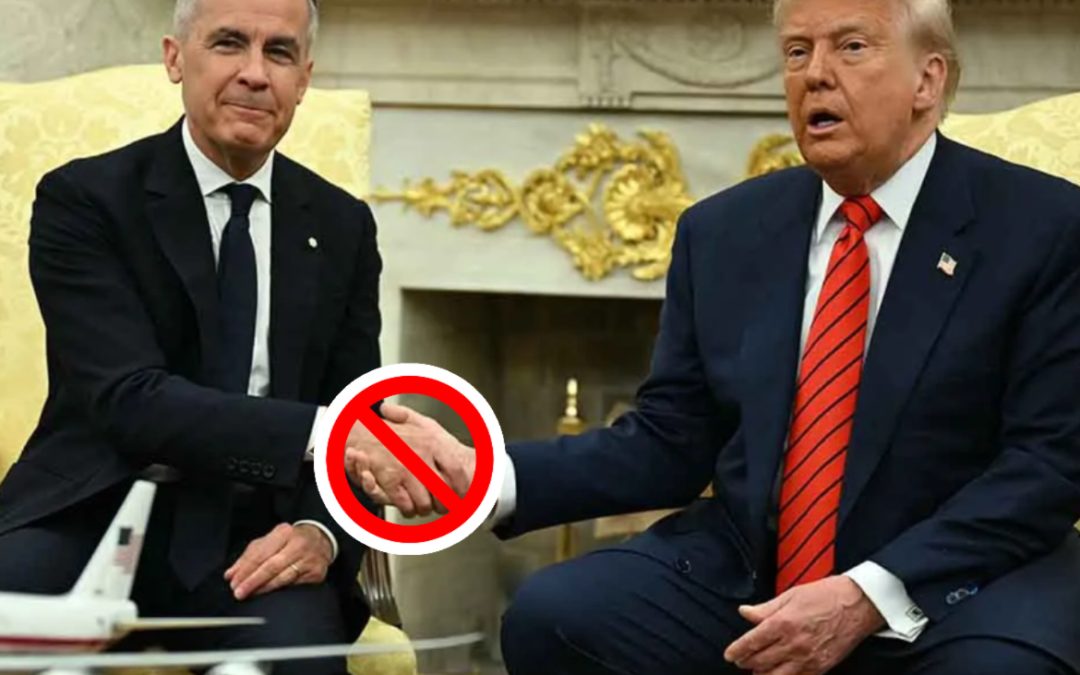Mark Carney’s handling of Canada’s trade relationship with the United States in 2025 has been an unmitigated disaster, marked by a complete failure to secure a trade agreement and a trail of broken promises that have left the Canadian economy teetering on the edge. His statement on the looming 35% U.S. tariffs, set to hit Canadian exports not covered by the Canada-United States-Mexico Agreement (CUSMA) on August 1, 2025, is nothing but a feeble attempt to paper over his incompetence. Instead of delivering a concrete deal to shield Canadian industries from crippling U.S. tariffs, Carney has resorted to vague platitudes about “building Canada strong” and “focusing on what we can control,” which are little more than empty words meant to distract from his inability to negotiate effectively with the Trump administration. His leadership has been exposed as utterly inadequate, and his refusal to take responsibility for the absence of a trade deal underscores why he deserves zero credibility. The economic fallout from his failures is already hammering Canadian workers and businesses, and his excuses only deepen the mess.
Carney’s initial bravado in March 2025, when he boldly declared Canada would secure a “strong deal” with the U.S., has proven to be nothing but hot air. By July 22, 2025, he was backtracking, admitting there was little hope of avoiding tariffs, a stark reversal from his earlier confidence. This flip-flop, as highlighted by posts on X, reveals a leader who either misjudged the situation or deliberately misled Canadians about the prospects of a deal. His July 15 acknowledgment that a tariff free agreement was unlikely for any nation, including Canada, was a pathetic admission of defeat, especially after he had spent months hyping his ability to negotiate with Trump. The New York Times reported Carney’s shift from optimism to resignation, noting his earlier deadline of July 21 for a deal was casually swept aside by Trump’s tariff threats. This isn’t leadership; it’s a masterclass in setting unrealistic expectations and failing to deliver, leaving Canadians to face the consequences of his miscalculations.
The economic damage from Carney’s failure to secure a trade deal is staggering, and his statement glosses over the severity with infuriating nonchalance. The U.S. tariffs, which include 50% levies on steel and aluminum and 25% on automobiles, are set to escalate to 35% on non-CUSMA compliant goods, threatening key Canadian industries. The Bank of Canada warned in January 2025 that prolonged tariffs could reduce GDP growth to zero, while the Tax Foundation estimated an average cost of $1,300 per Canadian household. Carney’s response? A vague promise to “protect Canadian jobs” and “invest in industrial competitiveness,” with no concrete plan to offset the immediate pain felt by lumber, steel, aluminum, and auto workers. His mention of “buy Canadian” policies and diversifying export markets sounds like a desperate attempt to pivot away from his failure to address the U.S. market, which still accounts for 75.9% of Canada’s exports, according to Statistics Canada. Diversification is a pipe dream when the U.S. remains Canada’s dominant trading partner, and Carney’s inability to face this reality head on is a betrayal of Canadian workers.
Carney’s attempt to deflect blame onto the U.S. for justifying tariffs with fentanyl concerns is particularly galling, given the facts don’t even support his narrative. He claims Canada accounts for only 1% of U.S. fentanyl imports, but data from CNN and the U.S. Drug Enforcement Administration pegs it at closer to 0.2%. This exaggeration, while minor, is emblematic of Carney’s tendency to fudge numbers to downplay his failures. Even if Canada’s role in fentanyl trafficking is minimal, Carney’s inability to leverage this fact in negotiations with Trump shows a lack of diplomatic skill. The U.S. has used fentanyl as a pretext, yet Carney has failed to call their bluff or secure concessions, instead touting Canada’s $1.3 billion investment in border security as if it addresses the core trade issue. It doesn’t. His focus on border measures is a distraction from the real problem: his government’s inability to negotiate a deal that prevents tariffs from devastating Canadian industries.
The statement’s lofty rhetoric about “nation building projects” and catalyzing “over half a trillion dollars” in investments is another hollow promise that Carney cannot back up. No specific projects or timelines are provided, and recent data offers no evidence to support such grandiose claims. This is Carney leaning on vague, feel good buzzwords to mask the absence of a trade strategy. His talk of cutting internal trade barriers and working with provinces and Indigenous partners sounds nice but does nothing to address the immediate economic threat posed by U.S. tariffs. The Globe and Mail reported on July 30, 2025, that current negotiations with the U.S. are less about technical trade details and more about political posturing, with Trump raising the bar at will. Carney’s inability to navigate this dynamic has left Canada at the mercy of a volatile U.S. administration, with no deal in sight and no clear path forward.
Social media sentiment on X further exposes Carney’s crumbling credibility. Users like @govt_corrupt and @MarcNixon24 have called him out for delivering “word salad” and failing to land a single win for Canada, with tariffs higher now than when he took office. These posts reflect a growing public frustration that Carney has done nothing but spin narratives to cover his tracks. His decision to scrap a digital services tax in June 2025, after Trump briefly suspended talks, was a humiliating capitulation that achieved nothing, as tariffs continued to rise. The New York Times noted this swift reversal as a sign of Carney’s desperation, yet it failed to move the needle on negotiations. His claim that Canada is in a “relatively privileged position” due to CUSMA exemptions is laughable when 62% of Canadian exports, per the White House, don’t comply with CUSMA and face crushing tariffs. Carney’s rosy framing is an insult to the businesses and workers bearing the brunt of his failures.
Carney’s broader economic vision, as articulated in his statement, is equally divorced from reality. His push for a “clean economy” and reduced reliance on oil and gas, as mentioned in X posts, alienates regions like Alberta while offering no immediate relief for tariff hit sectors. His focus on environmentalism over practical trade solutions is a tone deaf misstep that prioritizes ideology over jobs. The CBC reported on July 15, 2025, that Carney admitted Trump’s trade deals always include tariffs, yet he has no counterstrategy beyond accepting this as the new normal. This resignation is not the mark of a leader but of someone out of their depth, unable to adapt to a changing global trade landscape. Conservative Leader Pierre Poilievre’s accusation on X that Carney is “yielding ground” to Trump rings true, as every step of these negotiations has seen Canada lose leverage.
Ultimately, Carney’s statement is a masterclass in dodging accountability. His failure to secure a trade deal by the August 1 deadline, despite months of talks, has left Canada exposed to economic devastation. His earlier optimism, as reported by Bloomberg on July 22, 2025, about avoiding a “bad deal” has morphed into an acceptance of permanent tariffs, a capitulation that betrays Canadian interests. The lack of progress, coupled with his reliance on vague promises and misrepresentations, cements his reputation as a leader who cannot deliver. Canadians are now paying the price for his incompetence, with no trade agreement, rising costs, and an economy on the brink. Carney’s credibility is in tatters, and his statement is nothing but a flimsy attempt to spin a catastrophic failure into a narrative of resilience. It’s not resilience, it’s a train wreck, and he’s the conductor.


